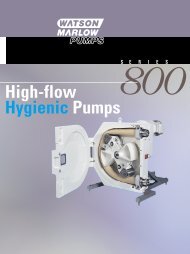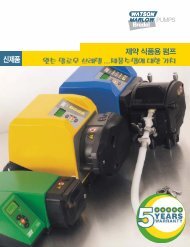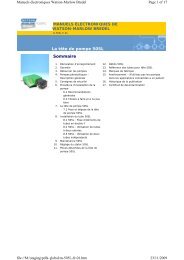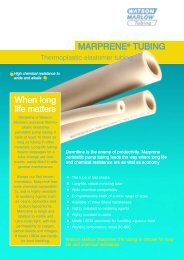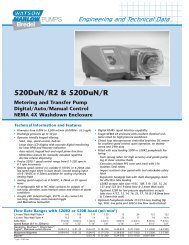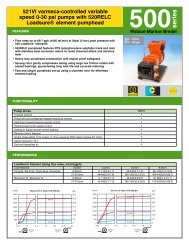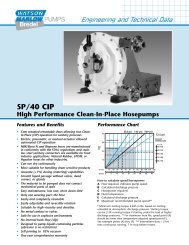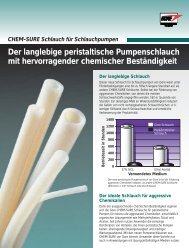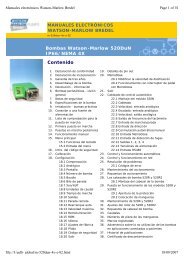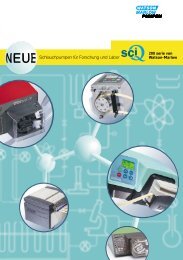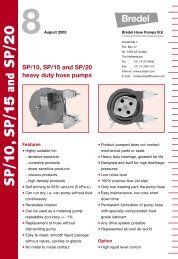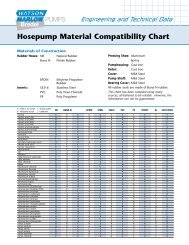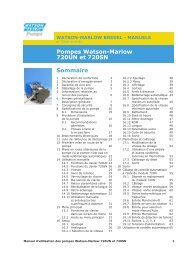Choosing the best tubing for your application - Watson-Marlow GmbH
Choosing the best tubing for your application - Watson-Marlow GmbH
Choosing the best tubing for your application - Watson-Marlow GmbH
Create successful ePaper yourself
Turn your PDF publications into a flip-book with our unique Google optimized e-Paper software.
<strong>Choosing</strong> <strong>the</strong><br />
<strong>best</strong> <strong>tubing</strong><br />
<strong>for</strong> <strong>your</strong><br />
<strong>application</strong><br />
Selecting <strong>the</strong> right <strong>tubing</strong> is as important as <strong>the</strong> choice of<br />
pump. <strong>Watson</strong>-<strong>Marlow</strong> Bredel pumps are designed around<br />
<strong>Watson</strong>-<strong>Marlow</strong> Bredel <strong>tubing</strong>, and using o<strong>the</strong>r <strong>tubing</strong> could<br />
result in reduced per<strong>for</strong>mance.<br />
A number of characteristics govern a pump’s per<strong>for</strong>mance.<br />
Suction lift depends on <strong>the</strong> tube restituting fully be<strong>for</strong>e <strong>the</strong><br />
advance of <strong>the</strong> next roller, drawing in <strong>the</strong> maximum amount<br />
of fluid. If it does not, flow rate will be reduced. Maximise suction<br />
lift by using <strong>the</strong> smallest practicable bore size of <strong>tubing</strong><br />
and run <strong>the</strong> pump at <strong>the</strong> slowest speed.<br />
The tube’s strength resists pressure, its flex resistance<br />
determines pumping life, its bore decides flow rate and its wall<br />
thickness controls pumping efficiency and flow stability.<br />
First use this guide<br />
The <strong>best</strong> way to select a tube is to use this guide to<br />
identify chemically suitable materials, and choose <strong>the</strong> one<br />
which <strong>best</strong> meets <strong>the</strong> physical demands of an <strong>application</strong>.<br />
Normally, use <strong>the</strong> longest-life material, which will usually be<br />
Marprene or Bioprene, if <strong>the</strong>y are chemically and physically<br />
suitable. For bio-pharmaceutical <strong>application</strong>s Pumpsil or<br />
Pumpsil-D platinum silicone are often <strong>the</strong> right choice. For<br />
industrial <strong>application</strong>s Neoprene is widely used.<br />
� For maximum tube life use a large-bore tube at low speed.<br />
� For maximum flow use <strong>the</strong> largest tube at maximum speed.<br />
� For maximum accuracy use a small-bore tube at high speed.<br />
Physical compatibility<br />
Temperature<br />
Marprene/Bioprene<br />
Neoprene<br />
Pumpsil/Pumpsil-D<br />
CHEM-SURE<br />
STA-PURE<br />
PVC<br />
What sizes fit which pump?<br />
The <strong>Watson</strong>-<strong>Marlow</strong> pump range uses tubes with bores<br />
from 0.13mm to 40mm. When choosing <strong>your</strong> tube, identify <strong>the</strong><br />
wall thickness <strong>your</strong> pumphead requires; <strong>the</strong>n select a bore<br />
according to <strong>your</strong> flow requirements.<br />
Unparalleled support<br />
Every <strong>Watson</strong>-<strong>Marlow</strong> company and distributor provides<br />
qualified technical support. If you have questions about tube<br />
per<strong>for</strong>mance or selection, <strong>the</strong>y will be pleased to help.<br />
Validation packs<br />
Validation packs are available <strong>for</strong> Pumpsil, Pumpsil-D,<br />
Bioprene and STA-PURE tube. Contact <strong>your</strong> <strong>Watson</strong>-<strong>Marlow</strong><br />
<strong>tubing</strong> representative <strong>for</strong> more in<strong>for</strong>mation, including validation<br />
in<strong>for</strong>mation on LoadSure elements.<br />
The chart shows <strong>the</strong> temperature range of each <strong>tubing</strong> type when suction and delivery pressures are negligible. Operating<br />
temperatures of Bioprene, Marprene, Chem-Sure, Sta-Pure and silicone <strong>tubing</strong> are limited to 80C, but may be autoclaved up to 135C.<br />
-4F 32F 70F 105F 140F 175F 212F<br />
-20C 0C 20C 40C 60C 80C 100C<br />
Pressure Choose <strong>the</strong> smallest tube bore which will give <strong>the</strong> required flow rate.<br />
Marprene/Bioprene<br />
Neoprene<br />
Pumpsil/Pumpsil-D<br />
CHEM-SURE<br />
STA-PURE<br />
PVC<br />
Low High<br />
Suction Choose <strong>the</strong> smallest tube bore which will give <strong>the</strong> required flow rate. Equally important is <strong>the</strong> restitutional power of <strong>the</strong> <strong>tubing</strong> material.<br />
Marprene/Bioprene<br />
Neoprene<br />
Pumpsil/Pumpsil-D<br />
CHEM-SURE<br />
STA-PURE<br />
PVC<br />
Low High<br />
Permeability<br />
Marprene/Bioprene<br />
Neoprene<br />
Pumpsil/Pumpsil-D<br />
CHEM-SURE<br />
STA-PURE<br />
PVC<br />
Tube wall and bore sizes, mm, appropriate to pumpheads<br />
Pumphead<br />
0.8 1.6<br />
Tube wall thickness<br />
2.4 3.2 4.0 4.8 9.0 12.8<br />
102R<br />
0.5-4.8<br />
205CA<br />
0.13-2.79<br />
313D/314D<br />
1.6-8.0<br />
313D2/314D2<br />
4.8-6.4<br />
314MC/318MC 0.13-2.79<br />
D1(B1)/D2/D3 0.5-4.0<br />
DM2/DM3 0.13-2.79<br />
R1<br />
L/L2<br />
0.5-6.4<br />
GM/VM2 to 4 0.13-2.79<br />
M1/N2<br />
0.5-4.0<br />
A<br />
0.5-2.0<br />
520R<br />
0.5-8.0<br />
520R2<br />
1.6-9.6<br />
520RE(L/M/H)<br />
3.2/6.4/9.6<br />
620R<br />
6.4-15.9<br />
620RE<br />
12.0/17.0<br />
720R<br />
9.6-25.4<br />
720RE<br />
12.7-25.4<br />
825<br />
25<br />
840<br />
40<br />
400 series<br />
High Low




